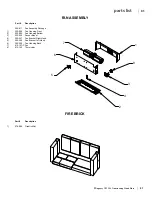
24
|
Regency CS1200 Freestanding Wood Stove
|
24
operating instructions
SEASONED WOOD
Whether you burn wood in a fireplace, stove or insert, good quality firewood is the key to convenience, efficiency and safety. Wet wood and pieces that are
not the right size and shape for your wood burner can be frustrating, burn inefficiently and deposit creosote that can fuel a dangerous chimney fire. Good
planning, seasoning and storage of the firewood supply are essential to successful wood burning.
•
Stack the wood in separate rows in an open location where the summer sun can warm it and breezes can carry away the moisture. Do not stack
unseasoned wood tightly in an unvented storage area.
•
Do not allow firewood to lie on the ground for more than a couple of days before stacking. Mould and rot can set in quickly.
•
Stack the wood up off the ground on poles, lumber rails or pallets.
•
The top of the pile can be covered to keep off rain, but do not cover the sides.
Softer woods like pine, spruce and poplar/aspen that is cut, split and stacked properly in the early spring maybe be ready for burning in the fall. Extremely
hard woods like oak and maple, and large pieces of firewood, may take a minimum of a full year to dry enough. Drying may also take longer in damp climates
There are a few ways to tell if wood is dry enough to burn efficiently. Use as many indicators as possible to judge the dryness of the firewood your are con
-
sidering. Here are ways to judge firewood moisture.
•
Using a moisture meter, select the species of fuel and then penetrate the pins into a split piece. Ideal moisture and seasoned firewood should be
less than 20% moisture content.
•
Checks or cracks in the end grain can be an indication of dryness, but may not be a reliable indicator. Some wet wood has checks and some dry
wood has no checks.
•
The wood tends to darken from white or cream colour to grey or yellow as it dries.
•
Two dry pieces banged together sound hollow; wet pieces sound solid and dull.
•
Dry wood weighs much less than wet wood.
•
Split a piece of wood. If the exposed surface feels damp, the wood is too wet to burn.













































